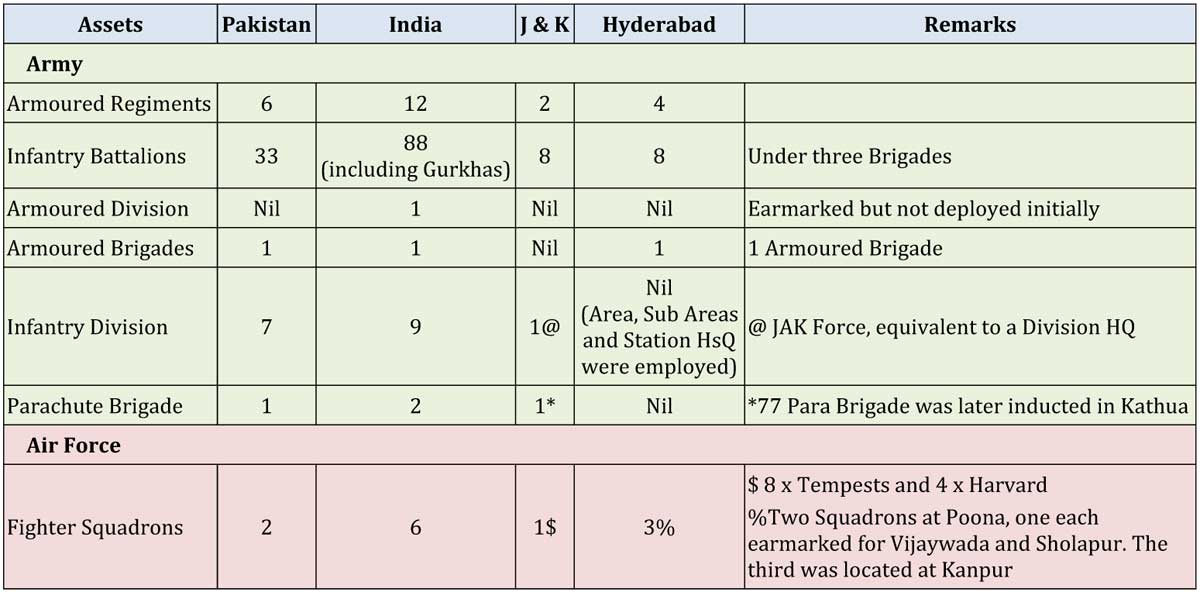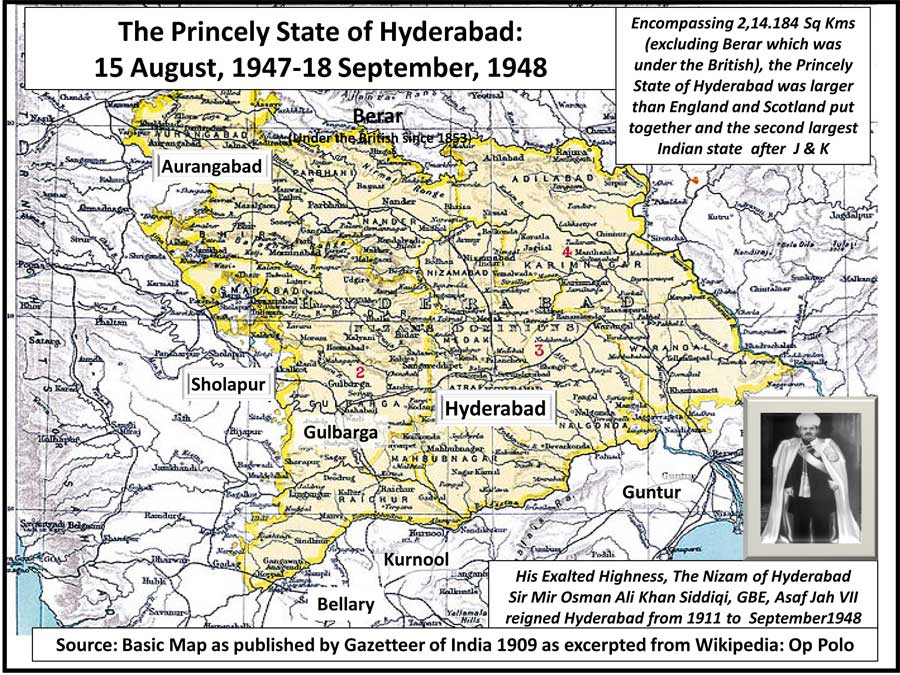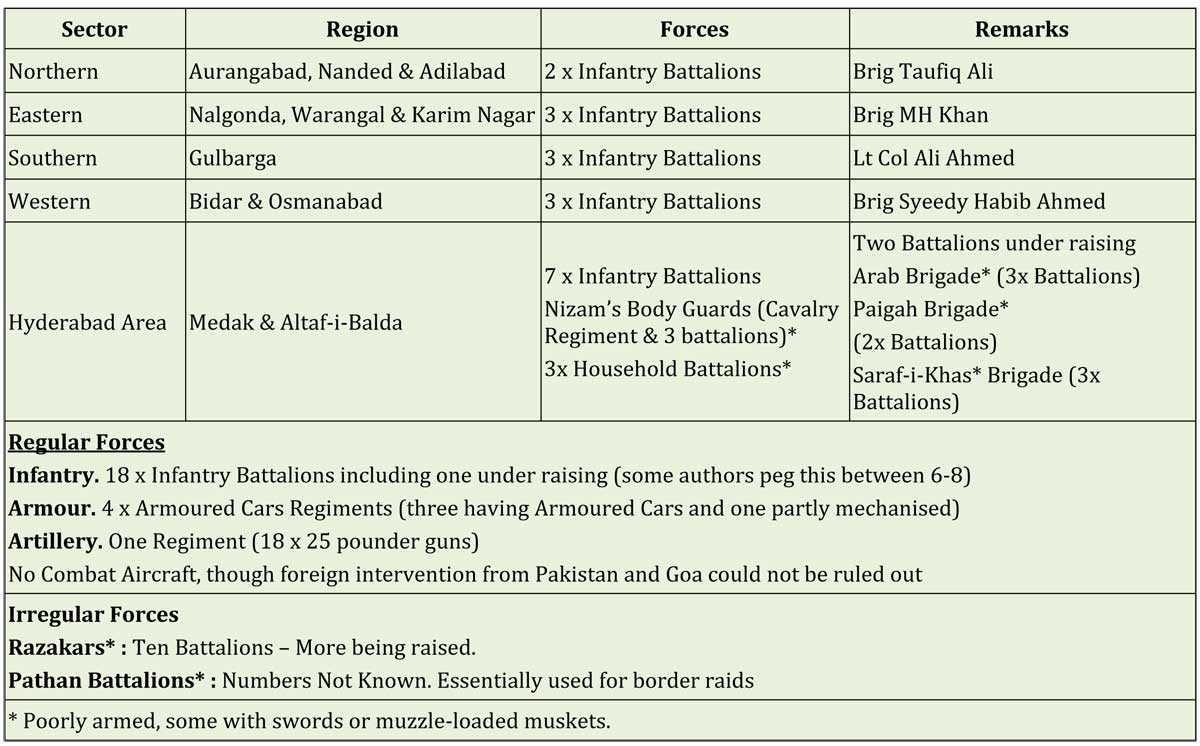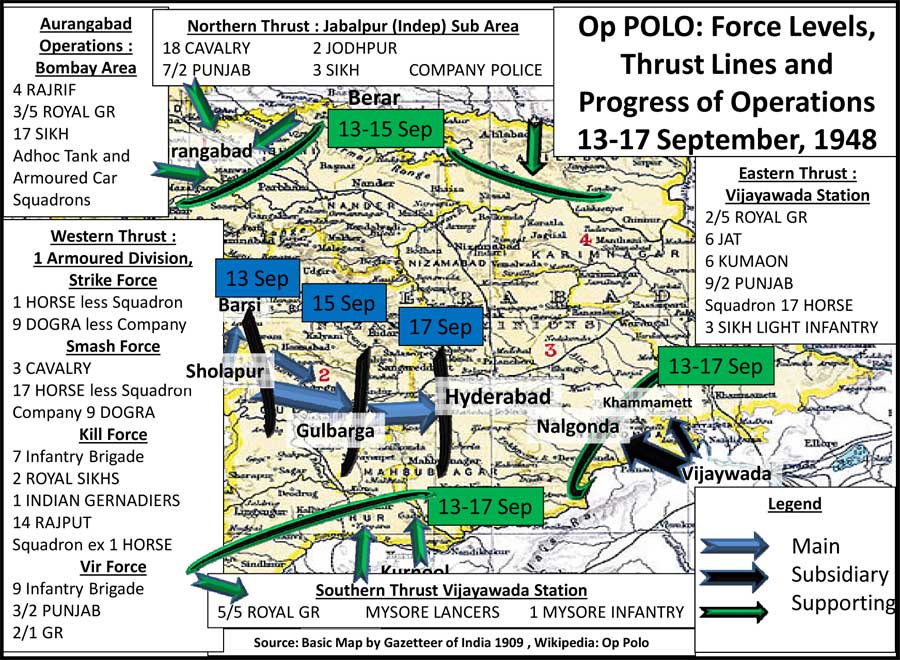Objectively speaking, the 108 hours campaign undertaken to liberate the Princely State of Hyderabad, codenamed Operation (Op) Polo stands out as India’s ‘first’ military success. Having said that, in view of its timing, (September 1948), and the forces it ‘dislocated,’ at a time when India was fighting a grim war in Jammu and Kashmir (J & K) and, it cannot be denied that the campaign deflected India’s operational focus and undermined the nation’s ‘main’ effort. To recapitulate the operation situation: By the time the Hyderabad operation was eventually undertaken, Pakistan had already annexed what is now ‘Azad’ Kashmir, occupied Gilgit and cut off Ladakh by capturing Skardu and Kargil.
War ravaged Britain was constrained to scuttle her liabilities, i.e. her global empire, including the jewel in the crown – India, the keystone of her Asian empire.
Despite such major operational reverses, Polo was still allowed to run its course, despite the fact that it ‘fixed’ combat resources desperately needed to restore the situation in Kashmir. This is not to suggest that the situation in Hyderabad did not require intervention, it did, but it is advocated that the situation could have been timed/handled differently. Admittedly, it is easy to build a hypothetical case with the ‘undue’ advantage of hindsight, the aim is to highlight the ramifications Polo had on Kashmir – a conflict that India not only lost in strategic terms, but which continues to cast its shadow on India’s progression.
Before coming to Hyderabad and Kashmir, Britain’s ‘post war’ compulsions need to be recapitulated. Despite emerging victorious, five years of gruelling war had sapped Britain financially; apropos, whatever visages of Pax Britannica she still harboured had to be (finally) laid to rest. War ravaged Britain was constrained to scuttle her liabilities, i.e. her global empire, including the jewel in the crown – India, the keystone of her Asian empire. Concurrently, after Stalin’s crushing defeat on Nazi Germany and his expansion into Europe, Soviet Russia had emerged as the new and ‘larger than life’ adversary. A vicious Cold War had already erupted and World War Three was expected to break out at any time between the former allies. Cutting to the bone, the competition was over oil, the ‘liquid gold,’ as control over the ‘wells of power’ not only yielded enormous economic power, but also fuelled the war machines of the new imperialists. Energy rich Gulf and the Middle East being the immediate spoils and since the Soviet shadow over the Gulf loomed large, the threat was clear and present.
Lord Wavell, India’s penultimate Viceroy, was the one to give practical shape to Mr. Churchill’s brainchild and it was he who transformed England’s economic liability of the times into a strategic opportunity. By fructifying the creation of Pakistan, he ensured that a bulwark against Soviet expansionism was finally put in place. With this strategic masterstroke, he also ensured Britain’s post-war strategic relevance for the new superpower – the USA, as it created the possibility for the use of military bases in Pakistan (Peshawar and Karachi); located on the flank of the Soviet Union, which were invaluable for retaining control over the Gulf. At the same time, creation of Pakistan also counter-balanced a potentially powerful India, whose support to the Soviet bloc due to the socialist leanings of her leadership could not be relied upon. The creation of a ‘credible’ Pakistan, therefore, was therefore England’s strategic requirement and Lord Mountbatten who replaced Wavell and then presided over the division of India and guided (sic) India through the Kashmir war was candid in admitting: “Having created it (Pakistan), its survival had to be ensured.”
…the impasse over Hyderabad’s refusal to accede to India, offered yet another way for the English to facilitate Pakistan’s war in Kashmir.
The Princely State of Kashmir being a part of their new creation was essential, as without Kashmir, or at least the parts she went on to annex, Pakistan’s heartland (Rawalpindi) remained vulnerable to a swift Trans-Jhelum offensive. Since English leaning during the Kashmir war are well-documented, they do not merit to be recounted. However, it needs to be pointed out that the impasse over Hyderabad’s refusal to accede to India, offered yet another way for the English to facilitate Pakistan’s war in Kashmir. By ensuring Indian deployment around the state, the English mandarins entrenched in South Block weaved a web of despondency and managed to balance the Indo-Pak force ratios in Kashmir. The upshot was that though Hyderabad was eventually liberated (after Lord Mountbatten had demitted office), ten months of diffused operational focus contributed largely to India’s inability to wrest the advantage in Kashmir.
The Hyderabad State in 1947- 48
With a population of 1.634 crores, not only was the state the most populous, but also the richest amongst the 542 Princely States and Provinces that formed British India. Occupying a pivotal place in the Deccan, the seventeen districts that made up the Nizam’s state, included Aurangabad in the North West and Gulbarga in the south. Since Berar was already under the British, it had already come under Independent India. At the same time, Sholapur, which formed an enclave in the west provided the shortest axis to Hyderabad. A map to highlight the extent of India’s second largest Princely State is given above.
Unlike J & K, which had a Muslim majority (77 percent), Hyderabad only had thirteen percent Muslims, though they held 97 percent of the public posts and controlled the army. Land-locked Hyderabad had well-developed links and was socio-economically conjoined with her neighbours. Though the state had her own currency, the economy was well integrated with British India, so much so that Indian currency was used concomitantly. This was unlike the case of J & K, which not only had a common border with Pakistan, but also was economically dependent on her for her survival.
…unlike Hari Singh’s dithering on the decision of accession, as early as 26 June 1947, the Nizam issued a ‘Firman’ (Royal proclamation) announcing his intent neither to join with India nor Pakistan.
Like Maharaja Hari Singh of J & K, Asaf Jah VII, the Nizam of Hyderabad, fabled to be one of the richest man in the world, did not want to lose his independent status. However, unlike Hari Singh’s dithering on the decision of accession, as early as 26 June 1947, the Nizam issued a ‘Firman’ (Royal proclamation) announcing his intent neither to join with India nor Pakistan. On the other hand, he sought an independent (dominion) status. Though this was rejected in view of the insular nature of the state, Mountbatten went on to offer a ‘standstill’ arrangement brokered through his ‘Tory’ friend, Sir Walter Monckton, who at that time was well entrenched as the Nizam’s Constitutional Advisor.
Taking advantage of the distraction provided by Pakistan’s tribal aggression, on 27 October, i.e. the day India intervened militarily in Srinagar, the Prime Minister was taken in custody on instructions of the Razakar leader, Kasim Razvi. The Razakars were the private army of the fundamentalist Ittehad-ul-Musilmeen party and wanted to extend the writ of Islam over the length and breadth of South India. In that, they had the support of Hyderabad’s Commander-in-Chief, Major General El Edroos, an Arab mercenary. Rattled by the developments but helpless against the fundamentalists, the Nizam succumbed and appointed Mir Laik Ali, the nominee of Razvi as the new Prime Minister; de-facto control thus shifting to the separatists. The leadership in New Delhi, pre-occupied with the war in Kashmir still preferred to negotiate and an (inconsequential) standstill was finally signed on 29 November.
Emboldened by Delhi’s demure reaction(s), Laik Ali pressed for the removal of Indian Forces and concurrently renewed efforts for supply of arms from Britain and Pakistan. Despite Hyderabad’s declared neutrality, he appointed an agent for Pakistan and even extended a loan of Rs 20 Crores to help her war with India. Concurrently, the strength of Razakars was increased and by the spring of 1948, armed raids on Indian enclaves and border villages and the growing belligerence of the Razakars, made it incumbent for the Indian government to finally act. The strength of Hyderabad’s forces is tabulated, and though they may appear numerically strong, they were poor in training and in terms of armaments.[1]
Indian Forces
India and Pakistan shared the military assets of British India based on a ration of 2:1. However, despite the numerical advantage India enjoyed, the forces deployed by her in J & K and those opposite Hyderabad in the winter of 1947 is tabulated to present the bias. This is despite the fact that at that stage, there was a full-fledged war going on in Kashmir, compared to only a ‘preventive’ deployment around Hyderabad. In addition, vital assets, including air and armour were widely distributed against a trumped up Pakistani threat against the Indian states of Rajputana, Kathiawar, Assam and Bengal. Pakistan may have been worse off, but she had the advantage of hordes of fundamentally charged tribals.

Availability versus Deployment of Combat Forces: (Defence Cabinet Committee Meeting of 3 December, 1947)
Conduct of Op Polo
Though it is not intended to go over the detailed conduct of the campaign, an overview to highlight the fact that the opposition was highly over-rated and operational difficulties were deliberately played up by the English Generals who ran the show in South Block is presented. As per the appreciation carried out by Major General CE Pert, then commanding the Armoured Division (18 November), substantiated by Lieutenant General EN Goddard, the Southern Army Commander (28 November), it was assessed that the Indian forces stationed in Secunderabad would be incapable of defending themselves and being vulnerable, should be moved out. While this must have been correct, rather than building up their strength, assets were relocated out of Hyderabad, which would have encouraged the Razakars.
…combat air assets which are inherently flexible and whose aggressive employment could have made a major difference, were also fixed around Hyderabad against an illusionary threat.
The decision to pull out forces was despite the fact that as early as 20 January, the Government of India had specifically tasked Southern Command to ‘prepare a plan to ensure the safety of lives and property of Indian nationals and to prevent raids into India.’ Though, the intent may be defensive, it can be inferred that the situation was serious and required a military solution. Thus, pre-positioning and preparation were important.
The Issue of Timing and Force Levels
General Goddard presented his plan for the offensive into Hyderabad on 3 February and recommended a multi-directional offensive with the main thrust, spearheaded by the Armoured Division to be launched from Sholapur, synchronised with ‘holding’ operations to pin down state forces on the borders. Had the plan fleshed out in the first week of February been executed early, considerable forces could have been released for operations in Kashmir during the ensuing summer.
The situation in Kashmir needs to be co-related, as by then (February-March 1948), apart from regaining control over the valley, India had already lost Mirpur, Bhimber, Kotli, Rajauri, Muzzaffarabad, Chakothi and Gilgit, while Naushera, Punch, Uri, Bandipore, Skardu and Kargil were under threat. While it had been calculated by South Block that additional forces for Kashmir could not be sustained logistically, ways and means to at least bolster the forces fighting in the plains of Jammu could have been improvised. In any case, combat air assets which are inherently flexible and whose aggressive employment could have made a major difference, were also fixed around Hyderabad against an illusionary threat. Neither was India’s superiority in terms of armour ever considered to recapture Bhimber and Mirpur, located in the plains opposite Akhnur. Indeed, it was paradoxical that the open corridor from Akhnur leading to Mirpur was never exploited. On the other hand, repeated requests for desperately needed forces were deftly deflected; unfortunately for India and Kashmir, English counsel was allowed to prevail over the Indian leadership.
In terms of timing, since the decision to execute a military option had been accepted in principle, it may have been prudent to complete the operation at the earliest. Not only would this have freed Indian forces, but also denied preparation time to the adversary. Ideally, March could was suitable as the bulk of the forces were in place and the monsoons were still two months away. Dithering and delays proved costly in the context of the Kashmir war.
Conduct of Operations
Despite the stated aim for ‘executing a rapid seizure of Hyderabad’ without worrying about the Lines of Communication,[2] the offensive that went in was deliberate and methodical. Notwithstanding, against a cautious time envelope of fifteen days, General Chaudhari, forced an unconditional surrender on Edroos within five days, exposing the myth of superiority of Hyderabad’s forces and the hype around the Razakars and the motley lot of Irregulars. However, Chaudhari still had the difficult task of rounding up the separatists and though Razvi was picked up, this took time and consequently, no forces could be made available from Hyderabad for Kashmir. The progress of operations, thrust lines and forces employed are annotated on the map:
Conclusion
Despite many distraction(s), it was creditable that the campaign was still taken to its logical conclusion. There was palpable synergy not only within the Army and the Air Force, but also with the Civil Administration. In the words of Major General (later Chief) JN Chaudhuri, the architect and principal actor: (it) was a brief incident, satisfactorily planned and against forces, who after the third day, virtually collapsed.’
Having said that, the question this account started with remains: Was this operation needed? If so, could it have been timed/executed differently? Though this hypothetical question has more political than military connotations, it highlights the importance of ‘deciding on the ‘right’ action at the ‘right’ time.’
Complex challenges are emerging on India’s strategic horizon and it is incumbent on the new leadership that has taken guard in New Delhi that not only do they work out their priorities, but also think through ‘how’ and ‘in what manner’ they should act/react. ‘Fighting/preparing for the ‘right’ war at the ‘right’ time with the ‘right’ forces is the panacea for success but to ensure this, operational contingencies need to be thought through with deliberation and preparations ensured in peacetime.
[1] As given in the he Assessed Order of Battle of 1 Armoured Division’s Operational Order No 3 of 30 August, 1948, appended in Op Polo: The Police Action against Hyderabad, 1948, Historical Section, MoD, Government of India, New Delhi, 1972.








An Interview with Sam Manekshaw
https://cyrus49.wordpress.com/2021/11/27/19048/